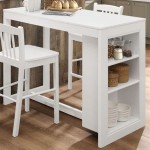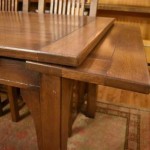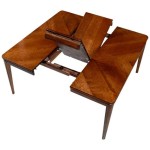The Enduring Appeal of Solid Wood Vintage Dining Tables
Solid wood vintage dining tables hold a unique position in the realm of furniture, representing a confluence of craftsmanship, history, and enduring style. These tables transcend mere functionality, serving as focal points for dining spaces and embodying a tangible connection to past eras. Their popularity stems from a combination of factors, including the inherent beauty of solid wood, the distinctive design elements characteristic of vintage pieces, and the sustainable nature of repurposing existing furniture.
The term "vintage" applied to dining tables typically refers to pieces crafted anywhere from approximately 20 to 100 years ago. This era encompasses a broad range of styles, from the ornate Victorian designs of the late 19th century to the streamlined Mid-Century Modern aesthetic that dominated the mid-20th century. The defining characteristic is that these tables are not newly manufactured but rather possess a history and provenance that contributes to their overall value and appeal.
Solid wood construction is another key element defining these tables. Unlike modern furniture often made with engineered wood products like particleboard or MDF, solid wood tables are built from planks of actual trees. This inherent difference impacts not only the structural integrity and longevity of the table but also its aesthetic qualities, lending a natural warmth and character that is difficult to replicate.
The Aesthetic Value of Solid Wood in Vintage Dining Tables
The aesthetic appeal of solid wood vintage dining tables is multifaceted, stemming from the inherent characteristics of the wood itself and the design sensibilities prevalent during the table's period of manufacture. Different wood species offer varying grain patterns, colors, and textures, each contributing to a unique visual identity. For example, oak is known for its durability and prominent grain, while walnut boasts a rich, dark tone and a smoother texture. Mahogany, often used in higher-end vintage furniture, exhibits a reddish-brown hue and a refined grain pattern.
Beyond the wood species, the craftsmanship involved in constructing these tables plays a vital role in their aesthetic value. Vintage tables often feature intricate carvings, detailed inlays, and precisely executed joinery, reflecting the skills of master craftsmen. These details, often absent in mass-produced modern furniture, contribute to the unique character and artistic merit of the table. The patina that develops over time on solid wood, through years of use and exposure, adds another layer of visual interest, telling a story of the table's history.
Furthermore, the design styles characteristic of different vintage eras contribute significantly to the table's aesthetic. A Victorian table might feature ornate legs, elaborate carvings, and dark wood finishes, reflecting the opulent tastes of that period. In contrast, a Mid-Century Modern table would likely showcase clean lines, minimalist design, and lighter wood tones, embodying the modernist principles of functionality and simplicity. The design elements chosen during the table's creation directly influence its overall aesthetic impact and its compatibility with various interior design styles.
The aesthetic of a solid wood vintage dining table is further enhanced by its ability to blend seamlessly with different design styles. Whether integrated into a traditional, rustic, or contemporary setting, the natural warmth and character of the wood create a sense of timeless elegance. A vintage table can serve as a striking focal point in a modern dining room, adding a touch of history and personality to a minimalist space. Conversely, it can complement a traditional setting, enhancing the sense of warmth and comfort with its familiar design elements.
The Durability and Longevity of Solid Wood Construction
One of the primary advantages of solid wood vintage dining tables is their exceptional durability and longevity. Solid wood, by its very nature, is a strong and resilient material, capable of withstanding the rigors of daily use for decades or even centuries. Unlike furniture made with engineered wood products, solid wood tables are less susceptible to chipping, cracking, and warping. The inherent strength of the wood allows them to support heavy loads and resist the wear and tear associated with frequent use.
The quality of construction further contributes to the durability of these tables. Craftsmen who built vintage furniture often employed time-tested joinery techniques, such as mortise-and-tenon joints, dovetail joints, and tongue-and-groove construction. These robust joints ensure a strong and stable connection between the various components of the table, preventing it from becoming loose or wobbly over time. The meticulous attention to detail in the construction process ensures that the table can withstand the stresses of daily use without compromising its structural integrity.
Moreover, solid wood tables have the unique ability to be repaired and refinished, extending their lifespan indefinitely. Scratches, dents, and other blemishes that accumulate over time can be easily repaired by a skilled woodworker. The table can be sanded down and refinished to restore its original luster or to update its appearance to match current design trends. This ability to be restored makes solid wood vintage dining tables a sustainable and cost-effective investment, as they can be enjoyed for generations.
In contrast to furniture made with engineered wood products, which often require replacement after a relatively short period, solid wood vintage tables are built to last. Their durability and longevity translate into significant long-term savings and reduce the need for frequent furniture replacements, making them a more environmentally friendly choice.
The Sustainability and Environmental Benefits of Vintage Furniture
The decision to purchase a solid wood vintage dining table carries significant environmental benefits, aligning with principles of sustainability and responsible consumption. Opting for vintage furniture reduces the demand for newly manufactured items, thereby conserving natural resources and minimizing the environmental impact associated with furniture production.
The manufacturing of new furniture often involves the harvesting of timber, the processing of raw materials, and the transportation of finished goods, all of which contribute to deforestation, pollution, and greenhouse gas emissions. By choosing a vintage table, consumers actively participate in reducing these environmental burdens. They are effectively extending the lifespan of an existing product, diverting it from landfills and minimizing the need for new resource extraction.
Furthermore, vintage furniture often utilizes higher-quality materials and construction methods compared to mass-produced modern furniture. This means that vintage tables are less likely to require frequent replacement, further reducing resource consumption and waste generation. The durability and longevity of solid wood construction contribute to the overall sustainability of vintage furniture.
In addition to the environmental benefits, purchasing vintage furniture supports a circular economy, promoting the reuse and repurposing of existing products. This approach reduces the need for virgin materials and minimizes waste, contributing to a more sustainable and resource-efficient economy. By embracing vintage furniture, consumers actively participate in a more responsible and environmentally conscious approach to consumption.
The act of repurposing vintage furniture also fosters a greater appreciation for craftsmanship and historical design. It encourages consumers to value the quality and durability of older pieces, rather than simply discarding them in favor of newer, often less sustainable, alternatives. This shift in mindset promotes a more mindful approach to consumption and a greater awareness of the environmental impact of purchasing decisions.
Solid wood vintage dining tables offer a compelling combination of aesthetic appeal, durability, and sustainability. Their enduring popularity reflects a growing appreciation for the quality, craftsmanship, and environmental benefits associated with vintage furniture. As consumers become increasingly aware of the environmental impact of their purchasing decisions, the appeal of solid wood vintage dining tables is likely to continue to grow, solidifying their position as a timeless and sustainable choice for discerning homeowners.

Wood Parsons Table Dining Strong Oaks

Poplar Cherry Solid Wood Vintage Dining Table

Vintage French Provencal Farm Table Desk Dining In Solid Cherry Wood

550 Farm Table Harvest Kitchen Small Dining Farmhouse Inventiadesign Sustainable Solid Wood Antique Finish Etsy

Vintage Oak Base Distressed Dining Table

Antique Drop Leaf Table Wood Furniture Dining Farmhouse Kitchen Solid Etsy

Sold Antique Petite Jacobean Dining Table Solid Wood Vintage Furniture Etsy

Solid Wood Dining Table And Chair Combination Household Vintage Cherry Rectangular

Vintage Baker Extendable Solid Wood Dining Table And Chairs Set 6

Free Shipping The Turnbridge Rustic Refined Oval Dining Table Solid Wormy Chestnut Vintage Farmhouse Racetrack Shape








